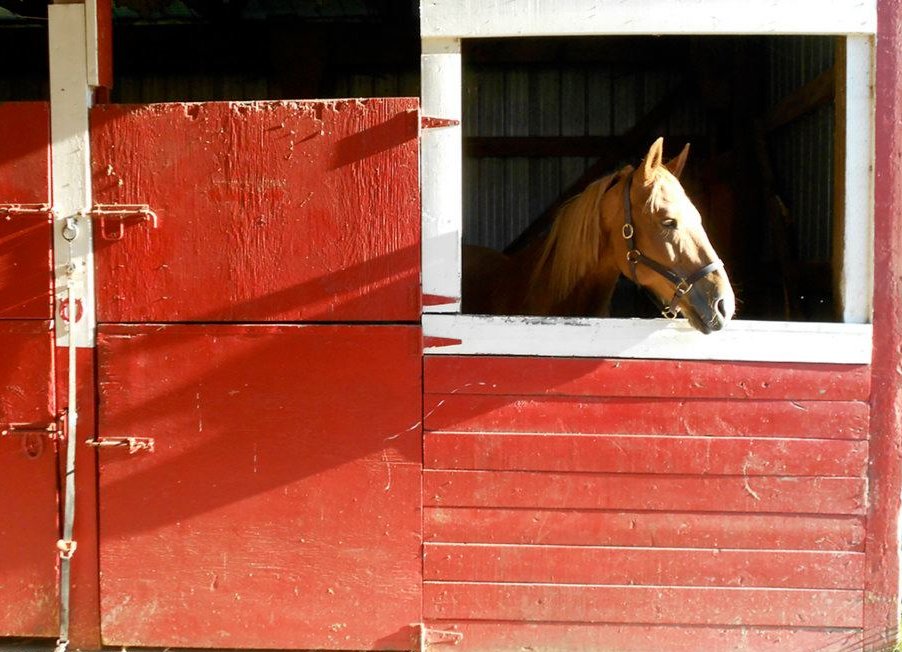Horsemanship Level 4: Stable & Pasture
The Stable & Pasture assessment for Level 4 requires you to:
2. Identify good & bad features of setup, emphasizing safety. Clean a stall, choice of tools.
This means you now need to apply judgement to your knowledge. Very few stables are ideal. We often wish our pastures, paddocks, or stalls were larger, better insulated or ventilated, or had better footing, more grass, fewer rocks, or less mud. Keeping horses is always a matter of compromise: the arid grasslands they evolved to roam upon don't exist in semi-urban areas, so we keep them confined for their safety, feed them hay and concentrates to replace grass, and put them to work for our own enjoyment. In lesson programs and as competition mounts they earn their keep, ensuring the species survives.
When you are reviewing your set-up for the examiners, keep three thoughts in mind:
- Is anything clearly unsafe?
- Are there things that could use improvement?
- What are the good features of the environment?
Safety
When discussing the environment with your examiner, make note of any safety concerns first. Is the fencing safe for horses, in good repair, with no loose boards or protruding objects? Are the gates and stall doors wide enough to let a horse through safely, and do they open outwards? Are there any natural landscape features that could pose a hazard, such as potholes, unstable stream banks, poisonous plants or shrubs? We hope the answer to all of these is 'no', but mentioning a lack of these hazards is important too.
Improvements
How could the situation be made better? Could nylon wire fences be replaced by post and rail? Could a top strand of electric wire prevent wood-chewing? Would more windows or better lighting help the airflow and safety in the stable? Some improvements are easy to make; others, such as changing the construction or footing may be beyond practical, but don't hesitate to mention 'ideal world' vs 'real world'.
Identify the positive
In general it's much easier to pick out faults than it is to say what's not wrong. As you critique your horse's stabling situation be sure to point out how the horses' needs -- for food, water, shelter, exercise and companionship -- are being met. Identify things like daily turnout, fresh water, paddocks that let horses interact safely, appropriate bedding, and posted feed schedules.
Before your test review chapters 14 - 17 of The Manual of Horsemanship (UK version) for the safest types of fencing, stall sizes, ceiling heights, watering options, bedding, etc.
Mucking out a stall
Be sure to get some experience cleaning stalls before your test. Practice makes for quick and efficient technique to impress your examiners. If you don't usually muck out at your stable, offer to help for a few mornings. No one ever turns down volunteer stall help!
You will need a wheelbarrow, manure fork or pitchfork, shovel, and broom. A close-tined manure fork works best with shavings or sawdust; a pitchfork is better with straw bedding.
- Use the fork to pick out manure and leftover feed.
- Use the fork and/or shovel to remove bedding that is wet with urine
- Add fresh bedding as necessary. If using pelleted bedding, mist with water to allow it to expand.
- Fluff up the bedding so it is even around the stall, and sweep back a foot or two from the stall entrance and from the feeding area. If bedding is deep, bank at the walls to prevent a horse from being cast (stuck on his back if he rolls).
- Clean and refill the water buckets or automatic waterer. Clean feed buckets if necessary.
Roughly once a week, depending on how messy your horse is, the stall will need to be stripped and the bedding replaced entirely. Some horses polish their feed buckets very well and these will only need rinsing once a week. Others leave food behind in their buckets, which will need to be emptied and cleaned daily.
Current and Upcoming Classes
The first series of Mounted Combat Fundamentals and Intermediate Mounted Combat begin this Sunday, February 7th. There are a few spaces left in each. There are also spaces in the Horsemanship Level 3-4. The Riding and Horsemanship classes and the Riding 3+ classes however are full, and the next series starts 13 March. All classes take place at Red Colt Co-op, 12320 No 2 Road, in Richmond.
Horsemanship Level 3-4
Sundays 31 January – 6 March, 10:30 – 11:30 am
cost: $130 + gst
Intermediate Mounted Combat
Sundays 7 February – 6 March, 1 pm – 3 pm
cost: $160 + gst
Mounted Combat Fundamentals
Sundays 7 February – 6 March, 1:30 – 3 pm
cost: $120 + gst
Mounted Combat Assessments
Sunday 6 March, 1:00 - 4:30 pm
cost: $50 for one assessment; $80 for two or more
one assessment included with each 5 or 6 week course
Beginner Riding & Horsemanship
Sundays 31 January – 6 March, 10 am – noon - FULL
Sundays 13 March - 17 April, 10 am - noon
cost: $300 + gst
Riding & Horsemanship Level 2
Sundays 31 January – 6 March, 10 am – noon - FULL
Sundays 13 March - 17 April, 10 am - noon
cost: $300 + gst
Riding Level 3+
Sundays 31 January – 6 March, noon – 1 pm - FULL
Sundays 13 March - 17 April, noon - 1 pm
cost: $200 + gst
Mounted Combat Playday
Sunday 3 April, 1:00 – 4:00 pm
cost: $15 + $15 for use of school horse
Free for ground crew & spectators!
